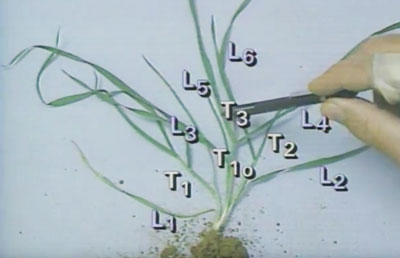 Figure 1. An image of a wheat plant with leaves (L) and tillers (T) highlighted. Source- Oklahoma State Extension.
Figure 1. An image of a wheat plant with leaves (L) and tillers (T) highlighted. Source- Oklahoma State Extension.
- Tiller numbers in the Spring are related to grain yields later in the season
- Wheat fields should be assessed for tiller numbers in the spring at green-up
- Fields with low tiller numbers should receive the earliest application of Nitrogen
- A tiller count of at least 90 tillers per square foot is typically required for high yield
A high yielding wheat crop begins with adequate seeds/acre and a timely Fall planting date. Seeds germinate, plants grow, and tillers are produced. Late planted wheat, or harsh winters could result in suboptimal tillering and subsequently, may require a shift in management considerations. Therefore, assessing your fields for tillers in the spring is an essential component of high yield wheat production. This publication will review how to evaluate tiller numbers and management considerations.
What are tillers?
Tillers are additional stems that attach at the crown (Figure 1). Tillers that develop from the axils of the first true leaves of the main stem are called primary tillers. Secondary tillers can develop from the base of primary tillers. Although most tillers will not survive to maturity, each tiller has the potential to develop into a head, and therefore they can be quite important in determining the overall yield in the crop. One feature that wheat has is the ability to tiller in the Fall and Spring. This means that tillers can help to fill in thin spots in fields. Fall tillers are essential in high yield wheat, and these tillers contribute more to overall yields. However, if we encounter a situation where our fall tillering levels were inadequate, or winter issues resulted in thinned stands, we can stimulate additional tillering during spring during the Spring [Feekes growth stage (FGS) 2-3].
Why assess tillers?
Assessing wheat populations needs to occur before the crop starts to green up in the Spring at FGS 2-3. In general, 65-70 heads per square foot are required for most high yielding wheat. To achieve that head count, approximately 90 tillers per square foot are required. More tillers are required because not all tillers will develop a seed head.
Assessing tiller number
How do you assess tiller number? There are a few methods, but the one described here is fairly straightforward. Grab yourself a stick, dowel, or PVC pipe and mark off the length of interest. Go into the field and count the tillers in a row at a minimum of five sites well-spaced across the field. To make your tiller counts, first count the number of plants per square foot. Next, count the stems per plant that have at least three leaves. Take the number of stems per foot and multiply that number by 12. Divide this number by the row spacing in inches. This results in the number of tillers per square feet. Table 1 can also be used to determine the length of row needed to equal a square foot.
Nitrogen and tiller number
Fields with low tiller counts should receive earliest nitrogen application to promote tiller development and growth. To help increase tillering, fields with counts below 50 should receive an application of 30 lbs nitrogen (N) per acre at FGS 2-3. The remaining N should be applied near the Feekes 5 growth stage. In general, a total spring N application rate of 1 lbs N per bushel yield is typical for high wheat yields, whereas no-till broadcast or streaming may require 1.2 lbs N per bushel yield. When determining your specific N requirements, ensure that you follow applicable state / regional nutrient management guidelines.
Table 1. Length of row needed for conversion of plants per square feet. From Penn State Univ Extension

Contact your FS Crop Specialist
Your FS Crop Specialist is here to help you with your nutrient management plans.
Learn more